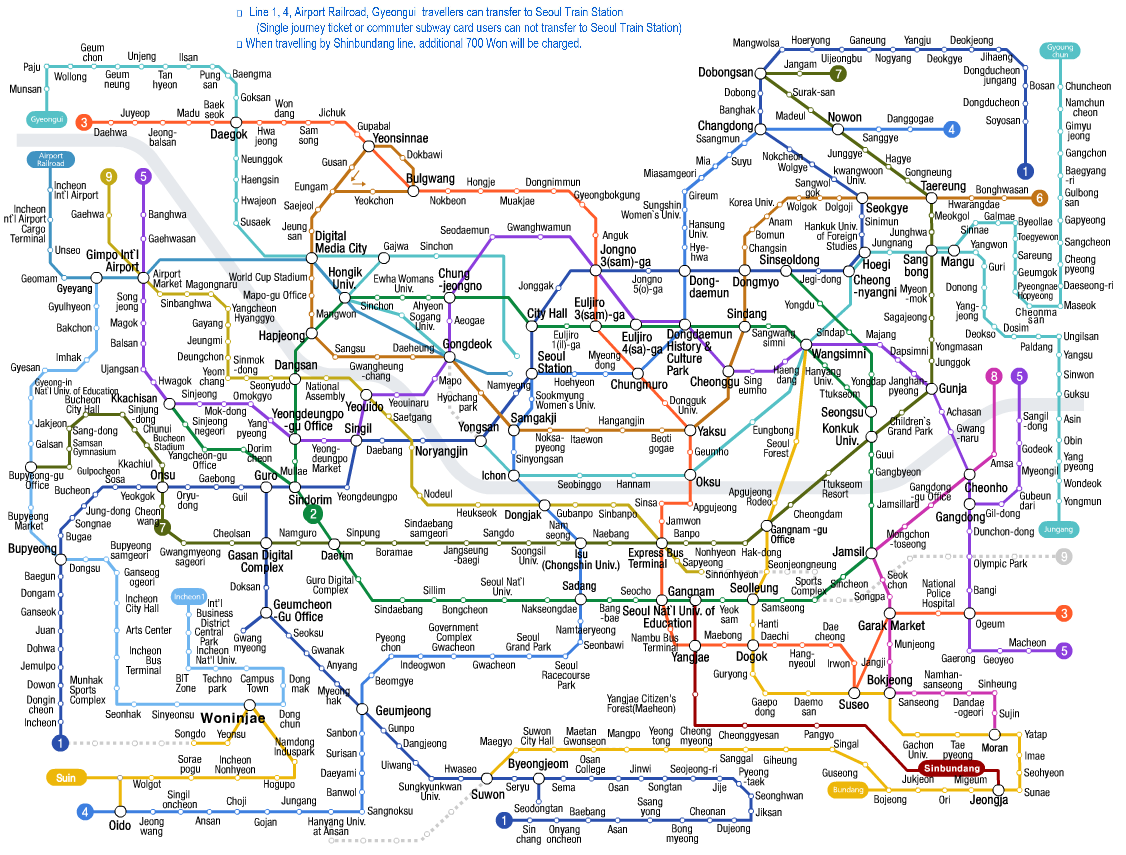PUBLIC TRANSPORTATION
Subways use the urban railroad system that has been constructed in Seoul. With Line 1 opening on August 15, 1974, there are now 9 lines currently operating.
Subway Information

| Line 1 | The first subway line to open in Seoul, it runs toward the downtown areas of Seoul Station, City Hall and Jongno Station. It connects to major metropolitan area cities such as Suwon, Incheon, and Cheonan. |
|---|---|
| Line 2 | This is the circular line that operates through the center of Seoul. It connects Gangbuk’s tourist sites such as Hongik Univ., Sinchon, Ewha Womans Univ., City Hall, Euljiro, and Dongdaemun History & Culture Park, as well as Gangnam’s major areas like Jamsil, Samseong, and Gangnam Station area. |
| Line 3 | This line stretches from Goyang-si and Ilsan in Gyeonggi Province to the southern area of Seoul. It connects the central areas of Gangnam such as Sinsa, Apgujeong, and Express Bus Terminal, as well as Anguk and Jongno 3-ga Stations, which are convenient for visiting Insa-dong. |
| Line 4 | This is the line that connects the northern and southern areas of Seoul. It is a convenient line for visiting Daehangno, Dongdaemun Market, Myeong-dong, and Namdaemun Markets, and getting to Seoul Station. |
| Line 5 | This line connects Gimpo Airport with downtown Seoul. Passengers can transfer to Line 1 and 3 at Jongno 3-ga Station. |
| Line 6 | This is a convenient line to see the World Cup Stadium and Itaewon. |
| Line 7 | This line connects Uijeongbu-si to the north of Seoul and the capital's Gangnam area. It is very crowded during commuting hours, and passes through Cheongdam-dong, a high-end shopping area. |
| Line 8 | This line connects southern Seoul and Seongnam-si, and is the line to take to visit Garak Market, the largest agricultural market in Seoul, and Munjeong-dong, which is famous for its outlet shopping area. |
| Line 9 | This is the newest line, opening in July 2009. It operates express trains and local trains, connecting Gimpo Airport to the Gangnam area in 30 minutes. |
| Bundang Line | This line connects the Gangnam area to residential areas on the outskirts of Seoul, from Seonneung Station in Gyeonggi Province to Bojeong Station in Giheung-gu, Yongin city. |
| ShinBundang Line | This line connects Gangnam-Pangyo-Jeongja Stations, which are operated by an unmanned system, the first of its kind in Korea. It passes through Yangjae Citizen’s Forest and the café street in Jeongja-dong, Bundang. |
| Jungang Line | This line connects Yongsan Station and Yongmun Station in Yangpyeong-gun, Gyeonggi Province. |
| Gyeongui Line | This line connects Seoul Station to Munsan Station in Gyeonggi Province. A train from Munsan Station goes to Dorasan Station, where passengers can get to the DMZ. |
| Gyeongchun Line | This line opened in December 2010, and connects Sangbong Station on Line 7 to Chuncheon Station in Gangwon Province. Passengers can use this line to get to Cheongpyeong, Gapyeong, and Chuncheon. |
| Airport Express | Airport Express trains pass through Incheon International and Gimpo Airports and run to Seoul Station; general trains stop at all ten stations, while through trains run express from Incheon International Airport to Seoul Station. |
Subway Fares
| Based on distance traveled |
Transport Cards | Single-use Card |
|
|---|---|---|---|
| Adult | Up to 10㎞: KRW 1,050 | KRW 100 added to the transport card fee |
|
| 10~40㎞: additional KRW 100 every 5㎞ |
|||
| Exceeding 40㎞: additional KRW 100 every 10㎞ |
|||
| Youth | Minimum charge: KRW 720 | No discount (single use fare) | |
| Child | Minimum charge: KRW 450 | Minimum charge: KRW 500 |
Using the Subway

- 1.Finding subway stations
- A subway sign and the station name can be seen at the entrance to each subway station. Station names are indicated in Chinese and English for foreigners
- Station numbers are also indicated in different colors, so passengers can easily recognize the subway line to which it connects.

- 2. Purchasing tickets
- As of May 2009, tickets have changed to single-use transport cards. Upon purchase of this type of card, a security deposit of KRW 500 is added, but this is returned at "Deposit Refund Device" machines after the card has been used.
- Prepaid transport cards are rechargeable, while transportation paid for with deferred payment cards are included in the related credit card statement.

- 3. Passing through a gate
- After purchasing a card, scan it to pass through the gate.

- 4. Transferring
- Transferring to another line is possible within the station, without passing through the gate again.
- Follow the signs or wall strips with the color of the subway line you wish to use.

- 5. Exiting
- To leave the subway station, scan your card and pass through the gate.
- Outside the gate, insert your single-use card into a "Deposit Refund Device" machine to get your security deposit returned (KRW 500).
Related websites
- Seoul Metro Line 1 ~ Line 4
- GO
- Seoul Metropolitan Rapid Transit Corp. Line 5 ~Line 8
- GO
- Seoul Metropolitan Rapid Transit Corp. Line 9
- GO
